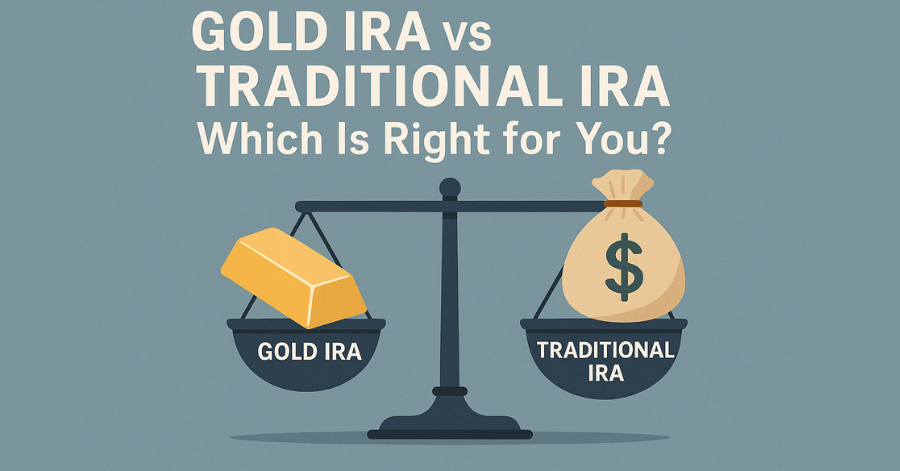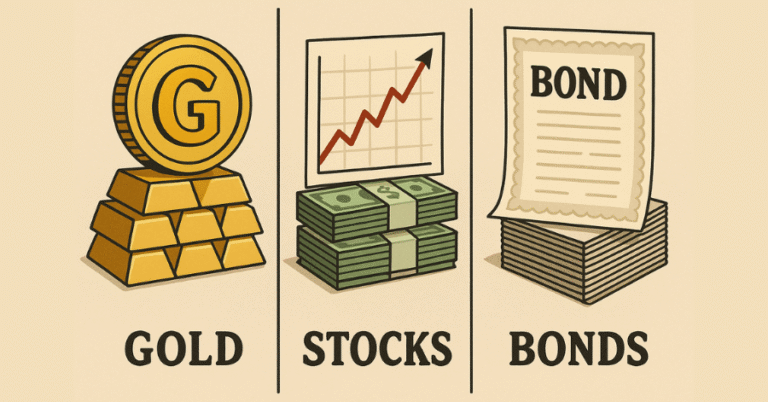Key Takeaways
- A Gold IRA is not a different type of account from a Traditional IRA; it is a Self-Directed IRA (SDIRA) that holds physical precious metals as its primary asset.
- A Standard Traditional IRA typically holds conventional paper assets like stocks, bonds, and mutual funds, managed by a brokerage firm.
- Tax rules and contribution limits are identical. For 2025, the contribution limit for all Traditional and Roth IRAs is $7,000 ($8,000 if age 50 or older), regardless of the assets held inside.
- The core difference lies in the assets’ purpose: paper assets are primarily for growth, while physical gold is for wealth preservation and hedging against economic instability.
- Gold IRAs involve unique costs not found in standard IRAs, including custodian, storage, and insurance fees, as well as premiums on physical metals.
A 2025 Guide to Assets, Fees, and Your Retirement
Are you confident your retirement savings can weather the coming economic storm? With persistent market uncertainty and inflation, understanding the difference between investing in physical gold versus traditional paper assets within your IRA could be the most crucial financial decision you make.
A common point of confusion for investors is the concept of a “Gold IRA vs. a Traditional IRA.” This comparison is misleading. A Gold IRA is not a separate category of retirement account; it is a specialized type of Traditional (or Roth) IRA that holds physical precious metals instead of conventional paper assets.
This definitive guide will clarify the fundamental differences, not in the accounts themselves, but in the assets they hold. We will break down the pros, cons, fees, and regulatory requirements to help you decide which investment strategy is the right path to secure your future.
Defining the Retirement Account Structures
Gold IRA vs Traditional IRA Debunked
To make an informed decision, one must first understand the vehicles involved. The distinction is not between two types of IRAs, but between a standard brokerage-managed IRA and a user-managed Self-Directed IRA.
What is a Standard Traditional IRA?
A standard Traditional IRA is a tax-advantaged retirement account offered by brokerage firms like Fidelity, Vanguard, or Charles Schwab. Investors contribute funds and use them to purchase a wide range of conventional financial instruments, including stocks, bonds, mutual funds, and Exchange-Traded Funds (ETFs). The primary goal is capital appreciation through market growth. These accounts are straightforward to open and typically have very low annual fees.
What is a Self-Directed IRA (SDIRA)?
A Self-Directed IRA is a specialized type of IRA that gives the account owner control over a much broader array of investment choices, including “alternative assets” not permitted in standard IRAs. These can include real estate, private equity, and, most notably, physical precious metals. An SDIRA requires a specialized custodian that is equipped to handle the administration and custody of these non-traditional assets.
A “Gold IRA” is a Self-Directed IRA
The term “Gold IRA” is an industry marketing term for a Self-Directed IRA that has been established for the purpose of holding physical gold, silver, platinum, or palladium bullion. It adheres to the exact same IRS regulations regarding contribution limits, tax deductions, and withdrawal rules as a standard Traditional IRA. The only difference is the asset held inside and the specialized custodian and storage facilities required to manage it.
Core Comparison: Physical Gold vs. Paper Assets in an IRA
The Truth Behind the Gold IRA vs. Traditional IRA Comparison Concept
The true choice an investor faces is what asset class best serves their retirement goals. Below is a comparison of holding physical gold in a Self-Directed IRA versus holding paper assets in a standard IRA.
| Feature | Physical Gold (in a Gold IRA) | Paper Assets (in a Standard IRA) |
|---|---|---|
| Primary Purpose | Wealth preservation; hedge against inflation, currency debasement, and systemic risk. | Capital appreciation; growth through market performance and dividends. |
| Risk Profile | Lower market correlation but subject to commodity price volatility; insulated from corporate or counterparty failure. While a safe haven, gold’s annual price swings average 15–16%, with some years exceeding 28%. | Direct exposure to market volatility, interest rate risk, and individual company performance (credit/default risk). |
| Counterparty Risk | None. You have direct legal title to a tangible asset held in a depository. | High. You own claims on third parties (shares in a company, bonds from a government/corporation, units of a fund). |
| Fees & Costs | Higher. Includes annual custodian, storage, and insurance fees, plus one-time purchase premiums. (See detailed fee table below). | Generally very low. Often limited to low expense ratios on ETFs or mutual funds. |
| Liquidity | Highly liquid, but settlement takes several days. Involves selling the metal through a dealer. | Extremely liquid. Can be sold for cash within seconds during market hours. |
| Complexity | Higher. Requires selecting a specialized custodian, a dealer, and an IRS-approved depository. | Lower. Can be opened and managed entirely online with a major brokerage in minutes. |
Export to Sheets
Understanding Gold IRA Fees, Regulations, and Risks
While offering unique protection, a Gold IRA comes with specific costs and regulatory requirements that are crucial for investors to understand.
Gold IRA Fee Structure
| Fee Type | Typical Range | Notes |
|---|---|---|
| Setup Fee | $50–$250 (one-time) | Charged by the custodian to open the SDIRA account. |
| Annual Maintenance | $75–$300 (annual) | Covers account administration and reporting. |
| Storage & Insurance | $100–$300 (annual) | Based on the value of holdings; paid to the secure depository. |
| Purchase Premium | 3–8% over spot price | The one-time cost of acquiring the physical metal from a dealer. |
Export to Sheets
Fee Comparison Disclosure: Compared to standard IRAs, where annual fees can be as low as $0–$50, Gold IRAs often carry total first-year costs of 4–6% of your principal due to setup, storage, and purchase premiums. These recurring and one-time fees can erode long-term returns.
IRS Regulations for Gold IRAs
- Approved Metals: Gold must be at least .995 fine, silver .999 fine, and platinum/palladium .9995 fine. Certain coins like the American Gold Eagle are permitted.
- Custodian Requirement: All IRA assets must be held by an IRS-approved custodian or trustee.
- Depository Storage: The physical metals cannot be held at home or in a personal safe deposit box. They must be stored in a licensed and insured third-party depository.
Regulatory Warning: The IRS and SEC caution that self-directed IRAs, including Gold IRAs, carry unique risks: high and sometimes opaque fees, illiquidity, exposure to fraud, and potential for significant losses. Investors should perform careful due diligence and understand all regulatory requirements before proceeding.
Conclusion: Gold IRA vs. Traditional IRA
Choosing the Right Asset for Your Retirement
The decision to invest in physical gold within an IRA is not a replacement for traditional retirement investing but rather a strategic complement to it. It is a defensive maneuver designed to preserve wealth and provide stability during periods of economic turmoil.
- A Standard Traditional IRA is suitable for investors focused on long-term growth who are comfortable with market volatility and want to minimize fees.
- A Gold IRA (SDIRA) is designed for investors who prioritize wealth preservation, seek a hedge against inflation and systemic financial risk, and are willing to navigate the higher fees and complexity involved with holding a real, tangible asset.
By understanding that the core difference lies in the assets—not the account’s tax status—you can make an informed choice that aligns with your personal financial goals and risk tolerance, ensuring your retirement savings are prepared for the future.
Ready to Take the Next Step? Choosing the right assets for your retirement is a crucial decision. Consult a trusted financial advisor and a precious metals specialist to tailor the right strategy for your goals.
FAQ: Gold IRA vs. Traditional IRA
Are the contribution limits different for a Gold IRA and a Traditional IRA?
No. The IRS contribution limits are identical for all IRAs (Traditional and Roth), regardless of what assets they hold. For 2025, the limit is $7,000, with an additional $1,000 catch-up for those age 50 and over.
Can I have both a Gold IRA and a standard Traditional IRA?
Yes. You can own multiple IRAs. However, the annual contribution limit applies to the combined total of all your IRA accounts.
Can I store the gold from my Gold IRA at home?
No. IRS regulations strictly require that all precious metals held within an IRA be stored in a licensed and insured third-party depository. Home storage is not permitted.
Is a Gold IRA always a Traditional IRA?
No. A Gold IRA can be set up as either a Traditional IRA (pre-tax contributions, taxed withdrawals) or a Roth IRA (post-tax contributions, tax-free withdrawals). The choice depends on your individual tax situation and retirement goals.








2 Comments